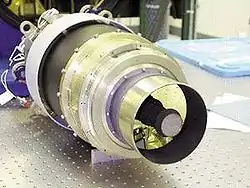Lightweight Exo-Atmospheric Projectile
The Lightweight Exo-atmospheric Projectile (LEAP) is a lightweight miniaturized kinetic kill vehicle designed to destroy incoming ballistic missiles both inside[1] or outside the Earth's atmosphere.[2] The warhead is delivered to the interception point by a system such as the Aegis Ballistic Missile Defense System.

Lightweight Exo-atmospheric Projectile
History
Development began in 1985 by the Strategic Defense Initiative Organization, which pioneered the development of miniaturized kill vehicle technology. It was originally created by the now-defunct Hughes Aircraft Company; the modern versions are developed and built by Raytheon.[3]
See also
References
- Strategic Defense Initiative: Some Claims Overstated for Early Flight Tests. DIANE. June 1993. ISBN 9781568066776.
- Paul Baker, Buster Kelley, Anne Avetissian, Lightweight exo-atmospheric projectile (LEAP) Space Flight Test, June 1992, performance validation, AIAA and SDIO, 2nd Annual Interceptor Technology Conference, Albuquerque, NM, June 6–9, 1993
- "Vehicle, Kinetic Kill, Lightweight Exo-Atmospheric Projectile". National Air and Space Museum. Retrieved October 14, 2021.
This article is issued from Wikipedia. The text is licensed under Creative Commons - Attribution - Sharealike. Additional terms may apply for the media files.